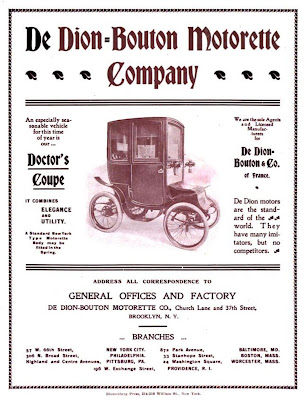Firstly, I said that only two models of the first project car survived. The one in a Bonhams auction that started my quest for more information, and another unknown one.
Well, I am happy to report that the unknown one is now known. I found a picture on an Australian car enthusiast's Flickr page. It was built in 1999 using an original crankshaft and flywheel. Everything else was made by hand, including the crankcase.
The Veteran Car club, THE authority on veteran and vintage cars around the world, have certified it as a 1902. Because even though the age of the contemporary parts and the original construction articles were faithfully followed, there were several improvements to the original design detailed in the letters pages of the EM that this new construction has incorporated. The car currently resides in the McFeeters Car Museum, in Forbes, NSW, Australia, and makes regular visits to car shows. You can find another picture of the car on the museums Facebook page.
 |
| English Mechanic No.2 (image courtesy of Classic Cars Australia) |
I have remarked in earlier posts, that there seems to have been an informal link between the two magazines in that they would share articles, photographs, and drawings.
The drawings of Hyler White projects were one of the things shared between the two publications. However in the editorial introduction to this project they were non too complimentary in what they had to say.
"It might appear from the wording of the articles that the vehicle is intended to be built by amateurs and others from the drawings with which the article are illustrated. We do not believe that efficient vehicles of this class can be built by amateurs”.
Which is a bit of a surprise when you look through the pages of The English Mechanic magazine and see all the glowing reports on projects built to, or inspired by, Hyler-Whites articles.
As the Horseless Age is a trade magazine, and this is still the early days of the automobile. The proprietors of the magazine have no idea if the automobile was here to stay or not, or if even the mass produced automobile would play second fiddle to home built personal projects. Maybe they were just protecting their interests, putting you off building your own car.
They go on to suggest that the engine probably lacks power, and that the transmission is less than effective for American uses. Even though in Europe vehicles of this kind have competed thousands of miles, as they freely acknowledge. So they really don't appear to be in favour of this undertaking. They invite criticisms from their readers and close the editorial by almost apologetically telling their audience that the series of articles may take some time to finish.
But the story of the construction of the second English Mechanic car gives me hope. Perhaps somewhere in an old barn here on the Minnesota Prairie, is an early 1900's 4hp engine sitting unloved and ignored. I could find it, restore it and bring it back to life. Then build a car around it using the plans and articles in the magazine. To begin such a project next year, the centenary of the passing of Thomas Hyler-White the designer, You have to admit there's a certain air of nostalgic romanticism there.
It almost certainly won't happen and I'll end up using my model making skills to build a scale model of the car instead. But we can all dream can't we?







